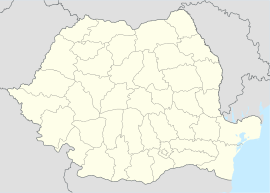world.wikisort.org - Romania
Huedin (Hungarian: Bánffyhunyad, Hungarian pronunciation: [ˈbaːnfihuɲɒd] (![]() listen); German: Heynod; Yiddish: הוניוד or הוניאד) is a town in Cluj County, Transylvania, Romania.
listen); German: Heynod; Yiddish: הוניוד or הוניאד) is a town in Cluj County, Transylvania, Romania.
Huedin
Bánffyhunyad | |
|---|---|
Town | |
 View of Huedin | |
 Flag  Coat of arms | |
 Location in Cluj County | |
 Huedin Location in Romania | |
| Coordinates: 46°52′12″N 23°1′48″E | |
| Country | Romania |
| County | Cluj |
| Government | |
| • Mayor (2020–2024) | Mircea Moroșan[1] (PNL) |
| Area | 61.24 km2 (23.64 sq mi) |
| Elevation | 556 m (1,824 ft) |
| Population (2011)[2] | 9,346 |
| • Density | 150/km2 (400/sq mi) |
| Time zone | EET/EEST (UTC+2/+3) |
| Postal code | 405400 |
| Area code | +40 x64 |
| Vehicle reg. | CJ |
| Website | www |
Huedin is located at the northern edge of the Apuseni Mountains. It is surrounded by the villages of Nearșova, Domoșu, Horlacea and others. The town administers one village, Bicălatu (Magyarbikal). Lately, Huedin has started to be known for its ecotourism initiatives.
Population
| Year | Pop. | ±% |
|---|---|---|
| 1930 | 5,401 | — |
| 1948 | 5,134 | −4.9% |
| 1966 | 7,834 | +52.6% |
| 1977 | 8,378 | +6.9% |
| 1992 | 9,961 | +18.9% |
| 2002 | 9,955 | −0.1% |
| 2011 | 9,346 | −6.1% |
| Source: Census data | ||
The 2011 (census data) of the town's population counted 9,346 people, of which 59.32% were ethnic Romanians, 28.88% ethnic Hungarians and 11.45% ethnic Roma.[3]
History
The town of Huedin was founded in the Middle Ages. From 1330 up until 1848, the landlords of the town were the Bánffy family (see the town's Hungarian name of Bánffyhunyad). The town was part of the Kingdom of Hungary. In 1526, Huedin became part of the Principality of Transylvania and, until 1867, of the Grand Duchy of Transylvania.
The town boasts a strong historical Hungarian heritage. On September 26, 1895, Emperor Franz Joseph visited Bánffyhunyad following the end of Hungarian Army manoeuvres in Transylvania and was given an enthusiastic welcome by the townspeople, who built an arch decorated with the region's flowers and plants for the occasion.[4] In 1910, the town's population was 5,194, of whom 90.5% spoke Hungarian. At that time, 57.5% were Calvinist, 20.7% Jewish, and 10% Roman Catholic. From 1918 to 1940, the town was part of Romania. From 1940 to 1944, it was again part of Hungary, due to the Second Vienna Award. The town is home to a 13th-century Gothic Reformed Church.
Natives
- Samu Balázs
- Dezideriu Horvath
- Atilla Kiss B.
- Zsigmond Kolozsvári
Accessibility
The town is accessible by CFR trains from Cluj-Napoca and other cities, such as Oradea, Timișoara, Satu Mare, Brașov, Ploiești, Bucharest, and Budapest. Huedin also lies on the line connecting Budapest to Oradea and Cluj-Napoca.
Images
- View from Huedin
- View from Huedin
- Reformed church in Huedin
Notes
- "Results of the 2020 local elections". Central Electoral Bureau. Retrieved 11 June 2021.
- "Populaţia stabilă pe judeţe, municipii, oraşe şi localităti componenete la RPL_2011" (XLS). National Institute of Statistics.
- (in Romanian) Populaţia stabilă după etnie - județe, municipii, orașe, comune, National Institute of Statistics; accessed July 15, 2015
- Hubmann, Franz, & Wheatcroft, Andrew (editor) (1972). The Habsburg Empire, 1840–1916. London: Routledge & Paul. pp. 292–3. ISBN 0-7100-7230-9.
{{cite book}}:|author=has generic name (help)CS1 maint: multiple names: authors list (link)
External links
- (in Romanian) Huedin Business Center
На других языках
- [en] Huedin
[ru] Хуедин
Хуеди́н (рум. Huedin, венг. Bánffyhunyad Банфихуньяд, нем. Heynod Хейнод) — город на северо-западе Румынии, в жудеце Клуж. До 1848 года принадлежал венгерскому роду Банфи и назывался Банфи-Хуньяд.Другой контент может иметь иную лицензию. Перед использованием материалов сайта WikiSort.org внимательно изучите правила лицензирования конкретных элементов наполнения сайта.
WikiSort.org - проект по пересортировке и дополнению контента Википедии








